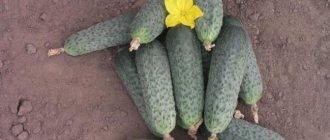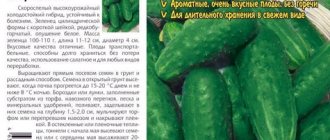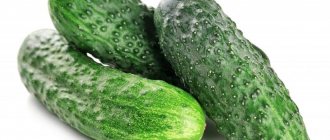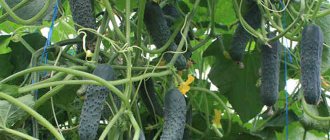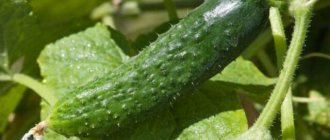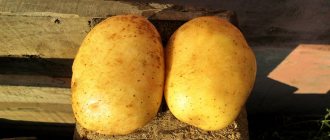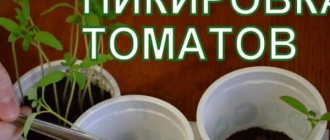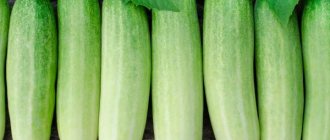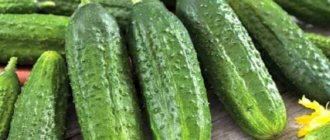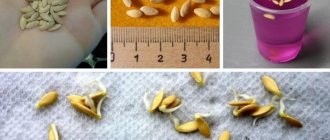If you are looking for a multi-purpose cucumber variety, take a closer look at the Director f1 variety. The description says that its cucumbers ripen by mid-summer; they can be salted, pickled, or cut into salads. The fruit has no bitter taste, and the flesh is crispy and aromatic. Many laudatory reviews with photos have been written about the variety. Cucumber Director f1 is chosen for planting by thousands of gardeners across the country.
Description of the cucumber variety Director
The description of the cucumber Director F1 begins with the fact that the plant is of the parthenocarpic type. The ovary occurs without the participation of insects in flower pollination. A feature of a self-fertile crop is that the seeds in adult fruits do not ripen. Zelentsy retains its taste and attractive presentation. Cucumbers grow evenly, the same size, do not tend to turn yellow, and remain tender and juicy even after they are overgrown.
The bushes of the hybrid variety Director F1 are highly branched, tall, and densely overgrown with foliage. Each node produces up to three ovaries. The main stem is not limited in growth. Lateral branches can similarly grow long.
For good fruiting, the hybrid variety Director F1 is grown according to the scheme of 3 bushes per 1 m2 of plot. The plant requires a vertical garter to the trellis. The main stem of the cucumber and always the side branches are fixed. To prevent the ovary from slowing down, the bush is formed with one trunk. The top of the main stem and side branches are pinched.
Advice! To prolong the fruiting of the Director F1 cucumber, the crop must be harvested every day, maximum every other day.
Other details about the Director F1 cucumber variety can be found in the video:
Description of fruits
Cucumbers grow from 9 to 12 cm in length. The shape is cylindrical. Basically all the fruits are straight. Occasionally, slightly curved specimens are encountered. The skin of the cucumber is densely covered with low pimples. The color of the vegetable is dark green. Light longitudinal stripes are slightly visible on the surface of the skin. The pimples have small white spines. The flesh is medium crisp and light green in color. There is never a void inside the cucumber. The average weight of one vegetable is from 65 to 80 g.
Features of agricultural technology
For this variety, there are two types of cultivation: open ground and seedling method. The hybrid form in terms of sowing is practically no different from most other varieties. Their seeds are placed in the ground slightly swollen. The ground temperature should be at least 15 degrees Celsius. Before planting, the soil must be thoroughly dug up and disinfected; it is advisable to do this in advance, for example, in the fall.
Advice! With the seed growing method, you can sow two grains at once in order for rejection to occur. Bad shoots will fade into the background and the strong will push out the weak.
You can resort to using trellises to form bushes in open ground conditions. The trellis must be fixed to the ground, at least two meters high. It can be made from wood. Tie the bushes to a trellis net. This makes caring for plants even easier.
You may be interested in:
Bush cucumbers (for open ground and greenhouses) - self-pollinating varieties Bush cucumbers are hybrids characterized by their compact size and weak branching. On short stems such...Read more...
The seedling method is simpler: planting is done with ready-made plants. If you follow certain steps, you will get a rich harvest:
- planting depth no more than 2 cm;
- when the first leaves appear, it is necessary to feed the roots;
- keep the soil moist.
Summer residents advise arranging plants in a checkerboard pattern to simplify care. Seedlings should be planted in such a way that there is at least 30 centimeters between plants, and a meter between rows, in open ground conditions. For every m2 there should be about four plants.
For good fruiting, it is necessary to care for the plants. Firstly, if you use the seedling method of growing, you need to water regularly and monitor the soil moisture. If you use the open ground method, you need to water more often, as there are dry days. It is recommended to moisturize in the evening. Secondly, fertilizing must be done frequently.
Summer residents use various solutions and home remedies. Also used:
- ash;
- humus;
- manure.
Thirdly, the variety needs to be formed, so excess pieces must be removed with garden shears, pinched, and the plant must be tied up, as it grows very quickly.
Recommendation! To achieve the greatest harvest, summer residents are advised to plant seeds or seedlings in the ground in which potatoes, cabbage or legumes grew. The land where the beans grew will not benefit the cucumbers.
Characteristics of the variety
Thanks to its good characteristics, the Director F1 cucumber is suitable for cultivation on an industrial scale. Many vegetable growers grow the variety commercially.
Productivity and fruiting
When growing the hybrid variety Director on an industrial scale, the average yield reaches 360 c/ha. With poor care and poor watering, the rate drops to 250 c/ha. If the cucumber is provided with optimal conditions with good irrigation, the yield will increase to 390 c/ha.
When privately growing cucumber Director F1 in an open way, up to 3.9 kg of fruit is collected from 1 m2. In greenhouse conditions, productivity increases. The indicator reaches 17 kg/m2.
The hybrid cucumber variety is suitable for the second rotation. The fruits of the mid-early crop ripen in 45 days.
Important! The Director gives high yields of cucumbers provided that the growth of the stepsons is limited. Excess shoots overload the root system and inhibit its development.
Application area
The delicate structure of the pulp and soft skin allow us to attribute the fruits of the Director variety to the salad category. However, cucumbers are great for canning. The vegetable is pickled and salted. For packing into jars, the greens are picked young, when their size is comparable to gherkins. Cucumber is tasty in fresh salads due to the complete absence of bitterness.
Resistance to diseases and pests
The Director variety is characterized by good resistance to fungal and viral diseases. The plant is shade-tolerant. In a greenhouse, if sanitary conditions are violated, white rot, similar to mold, may appear. The hybrid variety Director is moderately resistant to pests.
Advantages and disadvantages of the variety
According to reviews from gardeners, the Director F1 cucumber has the following positive features:
- high yield of the variety;
- attractive presentation of cucumber;
- plant resistance to diseases;
- universal use of fruits;
- possibility of growing in open and closed ways;
- shade tolerance;
- the possibility of using the crop for a second rotation.
The Director variety has no particular disadvantages. The disadvantage is the inability to independently collect seeds for propagation, but this factor is inherent in all hybrids.
Advantages and disadvantages
Among the advantages of the hybrid are the following::
- A powerful and medium-sized bush that does not require complex care.
- Great taste of cucumbers.
- Excellent transportability, the fruits do not lose their appearance or taste.
- Long-lasting fruiting compared to other cucumbers.
- Possibility to grow a hybrid twice per season.
- Tolerant to growing in the shade, giving the gardener more options for planting beds.
- Equally good harvest on different types of soil.
- Excellent regeneration abilities: the plant can easily recover from damage.
The disadvantages of the F1 Director include:
- The need to regularly remove a large number of stepsons. This procedure takes time, but it promotes the development of the plant and affects the harvest.
- Inability to collect hybrid seeds for the next season.
- Relatively high price for seeds compared to varietal cucumbers.
Features of planting and care
Every vegetable grower can grow a cucumber Director. There are two ways to grow this variety: seedlings and seeds. The first option allows you to get the harvest faster.
Planting seedlings
Growing Director F1 cucumber seedlings is much easier than, for example, tomatoes, eggplants or peppers. Seeds germinate quickly within 3-5 days. The vegetable grower gets the opportunity to harvest earlier.
The algorithm of actions is as follows:
- for seedlings of cucumbers of the Director variety, prepare plastic cups or buy cassettes with a cell size of 80x80 mm;
- the container is disinfected with a manganese solution or Extrasol-55 and filled with soil mixture;
- the grains are sowed to a depth of 2 cm, watered, covered with film, and seedlings are expected;
- when the grown seedlings have three true leaves, the cucumbers are fed with Radifarm;
- plants are provided with artificial lighting;
- Before planting, the seedlings are hardened off and the roots are moistened with Epin or Zircon.
Seeds of the Director F1 variety are sown in late April - early May. Seedlings are transplanted into a greenhouse or open ground when the air temperature reaches about +22°C and the soil warms up to +14°C.
Important! Scheme for planting seedlings of the Director F1 variety: in the greenhouse - 3 plants per 1 m2, outside - 4 plants per 1 m2. The bushes are planted in rows in a checkerboard pattern, forming row spacing 1 m wide.
Growing cucumbers using the seedless method
When the air warms up to +22°C and the soil to +14°C, Director F1 cucumbers can be sown directly into a bed in a greenhouse or garden. The method eliminates the unnecessary problem of growing seedlings, but delays the harvest time.
Before sowing, prepare the soil. In the greenhouse in the spring, the top layer of soil is removed, manure about 35 cm thick is poured in. The bed is watered with hot water so that the organic matter burns out. After 3-4 days, add a small layer of humus and soil, water the bed with a solution of potassium permanganate for disinfection.
Preparing soil outdoors involves digging up the area. Holes are made in the garden bed, manure or humus is poured in, and soil is covered.
Cucumber seeds of the Director F1 variety are immersed to a depth of 1.5 cm. The crops are watered, covered with a transparent film and removed only after germination. When planting densely, excess plants are removed.
Aftercare for cucumbers
According to reviews, Director F1 cucumbers require standard care. It is important for the plant to provide regular watering. Before the ovary begins, the procedure is carried out every three days. With the beginning of fruiting, the frequency of watering is increased. Water is used at room temperature. The norm for the Director variety is 30 liters per 1 m2. The amount of water is increased or decreased depending on the condition of the soil and weather conditions. After watering, the soil is loosened and weeds are removed.
The Director variety responds well to fertilizing. For cucumber, traditional, well-proven remedies are sufficient. At the initial stage, root feeding is carried out with ammonium nitrate. Urea or superphosphate will do. From organic matter, a solution of fermented manure or bird droppings is used for root feeding throughout the entire growing season. Additionally, the Director F1 variety benefits from weekly foliar feeding with solutions of mineral complexes.
The variety has excellent immunity and is very rarely affected in open ground. The plant is particularly resistant to powdery mildew, brown spot and mosaic. The danger to cucumbers comes from white rot, which occurs in a greenhouse under poor conditions. The disease manifests itself as a white mucous coating on the leaf plate. At the first signs, the affected foliage is removed, and all plantings are sprayed with a solution of 5 liters of water, 1 g of copper sulfate powder, 5 g of urea. Working fluid consumption is approximately 0.5 l/5 m2. If the disease is severely neglected, you can try to save the cucumbers with the fungicide Previkur.
Caring for the Director variety involves not only grueling work, but also pleasant moments of harvesting. With the beginning of the mass ovary, the fruits are collected daily, otherwise adult cucumbers will interfere with the setting of new greens. The harvest is harvested in the morning or evening. The cucumbers are placed in boxes, the harvest is sent for storage in a cool room: a basement or cellar.
Bush formation
If the Director variety is grown in a greenhouse, the bush must be shaped. The procedure is not necessary for open cultivation methods. When growing in the garden, it is enough to pinch the top of the main stem after 8 large leaves have grown on it.
In order to obtain an even bush when forming, the side branches of the cucumber are removed, and only one trunk is left. To obtain a lush bush, the side pagons are shortened to 6 leaves.
Features of cultivation
The agricultural technology of the variety does not differ significantly from the cultivation of other types of cucumbers.
But gardeners should know all the intricacies of growing the “Director” hybrid and its care requirements. According to the description of the variety, the “Director f1” cucumber is grown in two ways:
- seedlings;
- seedless.
The variety grows well when sown directly in the ground. With this method, you need to prepare the bed in advance:
- in the fall, remove all plant debris, apply fertilizer and dig deep;
- in the spring, pour a hot solution of potassium permanganate and dig again, now shallowly;
- level the soil and form ridges with row spacing for easy care of cucumbers.
Sowing in the ground
Sow the cucumber variety Director f1 in the ground with dry or soaked seeds. If the seeds are soaked, then you need to wait until they hatch. This is how suitable planting material is selected. The minimum value of soil temperature at which sowing of “Director” cucumber is allowed is considered to be +14°C.
Important! When choosing a location for cucumber beds, consider crop rotation requirements. Hybrid "Director" grows well after legumes (except beans), cabbage species, potatoes, onions
The "Director" hybrid grows well after legumes (except beans), cabbage varieties, potatoes, and onions.
Open ground planting pattern – 50x50 cm
For parthenocarpic and tall cucumbers, it is important not to violate the recommended distance. This will allow the plants to develop properly and produce high yields.
For 1 sq. m area you need to place no more than 3 cucumber bushes. The seeds are buried 2 cm. 2 cucumber seeds are placed in one hole, and in the true leaf phase the weaker specimen is pinched off.
Sowing seedlings
The seedling method allows you to get a harvest of cucumbers much earlier than when sowing in the ground. In order for the “Director” hybrid seedlings to grow strong and healthy, it is necessary to adhere to certain requirements.
- Seed preparation. According to reviews from summer residents, cucumbers of the “Director” variety have excellent germination (see photo). But some still soak them in a growth stimulant or disinfectant solution of potassium permanganate. If planting material was purchased in a licensed package, then the necessary preparation has already been carried out by the manufacturer.
- Soil preparation. “Director” cucumbers are well suited to ready-made soil mixture for seedlings, which you can buy. The second option is to prepare the soil yourself. You will need turf soil and humus in equal quantities. Then ash (0.5 cups), potassium sulfate (5 g) and superphosphate (10 g) are added to the mixture bucket. After mixing, the soil is spilled with a solution of potassium permanganate and calcined to disinfect it.
- Preparing containers. Cucumber seedlings do not tolerate transplanting, so summer residents try to do without picking. Separate plastic cassettes or containers, peat tablets or cups are prepared for seedlings. Plastic containers are washed with a disinfectant solution and dried. The drug "Extrasol-55" is suitable.
- Sowing. Fill the containers with soil mixture, leaving 1 cm to the top side. The soil is slightly compacted and moistened. Make holes 2 cm deep and lay out the seeds of the Director cucumber.
The optimal temperature for germination of cucumbers of the “Director” variety is + 22°С…+26°С. The seedlings also need to be provided with good lighting.
As soon as the first true leaf appears on the seedlings, the cucumbers are fed with complex fertilizer, for example, Kemira-Lux or Radifarm. When 3-4 leaves are formed, the “Director” seedlings can be transplanted to a permanent place. Before planting, seedlings are treated one leaf at a time with Epin or Zircon.
Cleaning and storage
The hybrid "Director" has an extended fruiting period. To ensure that the ovary continues to actively form, the greens are harvested daily or at most every 2 days. Remove the cucumbers from the vine in the morning or evening, using sharp scissors that will prevent damage to the shoots. Since the plants are of an open type, cleaning takes almost no time: the green plants are easy to reach.
The shelf life of the fruit is short - 3 days. To extend it for another period of time, fresh greens are wrapped in plastic wrap and sent to the refrigerator in the vegetable compartment or a cool basement. A large amount of the crop is processed. This is the only way to extend the life of cucumbers in food - in the form of pickles.
Caring for cucumbers after planting
Carrying out basic agrotechnical practices helps not only increase productivity, but also protect plantings from the spread of diseases and pests.
Watering and fertilizing
The watering regime is determined by the level of humidity in the region. In extreme heat, plants are watered every day in the morning or evening. In cloudy weather, watering is carried out once a week. Water consumption - 3 liters per bush. The water temperature should not differ greatly from the ambient temperature.
The maximum permissible limit is 5°C. If the soil is well mulched, then on hot days watering is carried out once every 3 days, and the above-ground parts are sprayed daily.
It is best to moisten the soil with a watering can with an elongated nose under the root.
Feeding is carried out 3 times throughout the season:
- 2 weeks after planting with the seedling propagation method and 1.5 months with the seed propagation method;
- during the flowering period;
- in the active fruiting phase.
Find out how to feed cucumbers to grow and increase yield.
For the first time, you can use any manure available. It must be diluted with water 1:1 and 500 ml is added to each well in the evening, and 2.5 liters of water are poured in the morning. The second time, an infusion of ash will be effective.
Add 500 g of ash to 10 liters of water and boil for 20 minutes, then immerse fresh nettle leaves (1 kg) in it for 2 hours. The solution is filtered and diluted with water 1:0.5. Nettles are used as mulch. In the active fruiting phase, foliar feeding is used.
You can use an infusion of yeast with nettle. To do this, add a pack of yeast (25 g) and 100 g of sugar to 10 liters of warm water (+30°C). After 2 hours, add 2 kg of nettle to the liquid and leave in the sun for 3 days. The resulting mass is decanted, diluted 1:1 with water and sprayed on the inside of the leaf.
Did you know? The first greenhouses for year-round cultivation of cucumbers were built in Ancient Rome to please Emperor Tiberius, who loved to feast on the refreshing fruits every day.
Formation and garter of a bush
You need to install a support next to each bush. If this is not done, the plants will lie on the ground, which increases the risk of developing fungal diseases and reduces yield. The simplest option is to install a horizontal support. To do this, 2 sticks 1.5 m high are driven in on both sides of the hole.
5-6 ropes are pulled between them at a distance of 25 cm from each other. With the appearance of each new shoot, it is attached to a new rope. To avoid the growth of lashes and entanglement of lateral supports, pinch the growth point when 8 pairs of leaves appear on the plant.
When the skeletal side shoots are formed, excess tendrils and new leaves are periodically removed when they reach a length of 2–3 cm.
Soil care
Once every 2 weeks, the soil is loosened to a depth of 5 cm near the bush and 10 cm between plants. At the same time, weeds are removed and the bushes are inspected for pests and disease damage. Afterwards the soil is mulched with compost.
If the soil is waterlogged, for example, it has been raining for a long time, mulching is carried out with sand mixed 1:1 with peat.
Control of diseases and pests of the variety
The culture is resistant to major diseases and pests.
However, if the rules of care are not followed, the following may be affected:
- powdery mildew - to eliminate the disease, the affected leaves and shoots are removed, the remaining parts and healthy plants are sprayed 3 times with an interval of 10 days with “Fitoverm” (40 ml/10 l of water);
- cladosporiosis - if a problem is detected, watering is canceled for 3 days, then the leaf is treated with “Fitosporin” according to the instructions.
Among the pests for this variety, aphids can become a threat. It is best to immediately use insecticides to combat it, since folk remedies are not very effective against rapidly multiplying livestock. You can use Inta-Vir (1 tablet per 10 liters of water) or Fitoverm.
Important! To avoid poisoning, all treatments with insecticides and fungicides should be carried out with gloves and a protective mask.
Landing nuances
“Director F1” is sown with dry seeds. But to obtain seedlings a few days earlier, it is permissible to sow with swollen seed. Since seeds are purchased annually, they do not need to be disinfected at home, as they are panned in production. When soaking for swelling, cracking of the shell is not allowed so as not to damage the protective layer.
